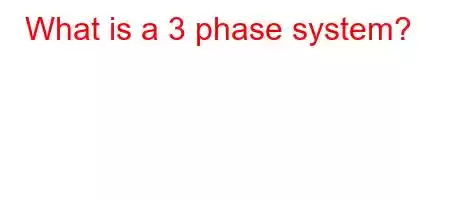Additive What is a 3-phase system?
Contents
What is a 3-phase system?
Three-phase electricity (three-phase electricity) is an electrical supply system used at high powers. = 1200 phase difference. In our country, these phases are generally called R, S, T phases. Phase names such as U, V, W or A, B, C can also be used.
Definition of three phases (Three-phase) Three-phase system consists of four wires, three conductors (phase) and a neutral. The conductors are out of phase and out of space at a distance of 120º from each other. The three-phase system is also used as a single-phase system. For low load, one phase and neutral can be taken from the three-phase supply.
What is the use of 3 phases?
► In 3-phase energy transmission, cable cross-sections can be switched to 1-phase. smaller than. Therefore, costs are reduced. ► A two- or three-phase system of the same size gives greater power than a single-phase system.
How does 3 phases occur?
If three sinusoidal waves are produced with a phase difference of 120 degrees between themselves, this is called three-phase called voltage or current. We learned how voltage is induced on an inductance (coil). Electric current is created by the movement of three coils between two permanent magnets.
What is 3-phase alternating current?
For this, three separate power lines with alternating current running in parallel with each other are required. however, each current phase shifts relative to the other phases by 1/3 of a cycle. Three-phase alternating current is produced in a generator with three separate windings in the power plant. A single-phase application can be connected between phase and zero.
Why 3 phases and 1 neutral?
The phase in which the energy is located does not receive a constant positive value like the positive pole in direct current, but the periodically changing plus and takes negative values. When the phase receives positive valence, it becomes the terminal with high potential and since the neutral is uncharged, the current flows from phase to neutral.
How to understand that it is three-phase?
Single and Three-Phase Counter Single-phase counters have a single phase; Three-phase meters have three different phases with equal power. For example, let's say that a three-storey house has a three-phase meter with a power of 9 kW, each of the phases in this house feeds a floor with a power of 3 kW.
Why is there no neutral at medium voltage?
Because each other is connected to each other. The sum of the currents passing through the three phases with a 120° phase difference compared to the other one becomes zero at any moment, so no current flows from the neutral point.
What does 3 phase 220 volts mean?
There are single phase or 3 phases. While the single phase to neutral is 220 volts, the voltage between phases is 380 volts. 3-phase receivers are used in places where more power is required. For example, single-phase induction motors can be made up to a certain kW value, while 3-phase ones can be made at the desired power.
How many volts are there in the electricity poles?
most of them use 220 V (single phase) or 380 V (three phase) electrical energy.
Read: 189


